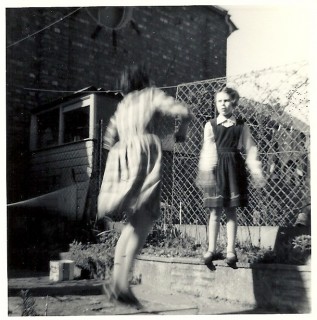15. No.16 Rampart Road

Rampart Road
Walking along Rampart Road today, it is difficult to envisage that, once, there were houses on both sides and it was a major highway, linking routes to London, Southampton and resorts along the south coast. Unfortunately, however, the increasing queues and gridlocks eventually led to the demolition of properties between St. Ann Street and Winchester Street, work on a relief road beginning in the late nineteen sixties.
Buildings may have disappeared beneath concrete and tar but memories of Rampart Road as it was before the construction of Churchill Way linger on.
If you look at the Stand photo, the top photo on this page on your right, No. 16 Rampart Road stood opposite the first lamp post outside Nos. 1-4 Rampart Road.
Rita Jacob tells her story
No. 16, which was my home between July 1948 and July 1969, was one of a group of houses that had front doors up to forty five centimetres below pavement level, a low brick wall enclosing a small paved area around a bay window. At the rear of the building, however, the garden was less than two metres below the back bedroom window and was reached by climbing eight steep brick steps located at the end of a yard. Near the steps, was the only toilet; nearly all the houses on our side of the road being without bathrooms. Two tin baths hung on the fence nearby, these being taken into the house when required and filled with water boiled on the stove.
Like most of the properties in Rampart Road, No. 16 had a hallway leading to a sitting room and a separate dining room where we spent most of our time. The kitchen or scullery could only be accessed from the latter, the other door opening on to the yard which had no back entry. Therefore, when the coalmen called, sacks had to be humped through the hall and dining room as well as across the kitchen itself, the coal house door being in the far wall.
The stairs at the end of the hall led up to a split landing and three bedrooms; the largest being the one over the sitting room. In the late 1940s, only two of these rooms were habitable, the landing and stairway also being in a dilapidated condition with the dark grey wallpaper hanging off the walls. Yet, by the time we left, my father had modernised and completely redecorated No. 16; the council house that we were allocated being in a much worse state!
Like the other children who lived in Rampart Road, my sister and I were not allowed to play outside on the pavement as, with the growth of motor transport, it had become much too dangerous to do so. Therefore, we had to play either inside the house or in the garden which was overlooked by the Invicta leatherworks. These restrictions made us more inventive, the area under the dining room table and chairs becoming a dolls’ hospital or palace while the stairs were used as tiers of theatre seats for ‘performances’ in the hall.
At Christmas, Rampart Road became a fairyland when darkness descended, most front windows containing a tree decorated with coloured lights. The residents also celebrated major events together, houses being draped with flags on VE Day and Coronation Day. On both occasions, the road could not be closed so tables were squashed together on the pavement for the VE Day party; the Tollgate Inn gardens and St. Martin’s Church Street being used for the Coronation festivities. Sadly, by the time Salisbury celebrated the Silver Jubilee in 1977, the community was no more; families choosing not to be rehomed in the Tollgate flats which were scattered across the city. Nevertheless, in my memory, the houses and their occupants live on!
I wrote ‘Ode to Rampart Road’ soon after I became involved in the Milford Street Bridge Project. For over forty years, I had avoided the site of my former home, finally standing opposite on the day I was interviewed at St. Martin’s School.
Listen to Rita Jacob reading her poem in the audio clip on the right of this page or your downloaded MP3 on the Download page.
Our walk finishes here. We hope you have enjoyed it.
To return back into the City or the car park, continue down Rampart Road until you get to Milford Street Bridge Mural. Continue down Milford Street to go into the City or retrace your footsteps back to the car park.
Take a trip down Memory Lane,
Where I am a child again,
And terraced houses can be found,
Instead of tarred and concrete ground,
Decked in flags as in fifty three,
Or, in front windows, a Christmas tree,
Then, behind each painted door,
Familiar faces appear once more,
Diddy, Elsie, Jack and Bill,
Mum and Dad with sister, Jill,
Mr Wilder who clears the drains,
Ruth and Betty, Mrs Bains,
All members of a community,
Consigned to the pages of history!
* * *
Race along the paving stones,
To the shop Miss Lanning owns,
Inside, the oil stove spits and flares,
Illuminating the feline stares,
Buy a comic, a toffee strip,
Four farthing chews and a sherbet dip,
Go out the door, back up the road,
Watch coalman, Ben, hump a load,
Pass Bertie, in his long brown coat,
Pulling the electric baker’s float,
Now, if it is a market day,
A herd of cows may come your way,
Driven by Percy, swinging a cane,
Bound for the Milford cattle train!
* * *
Each day Mum buys fresh food to eat,
So off you go, down Milford Street!
St. Martin’s Hall is at the top,
Further on, Ralph’s corner shop,
Goodfellow’s interior is dark and old,
Smells earthy like the produce sold,
Creep over to the barrel with metal bands,
And into the grape bran plunge your hands!
Michael and Doris sell fruit from a stall,
Just inside their cavernous store,
Across the entrance, Solomon sprawls,
A shaggy St. Bernard with massive paws,
Finally, to Foster’s, a patisserie dream,
Selling confections of jam and cream!
* * *
Visit the Greencroft or Riverside,
Bag a swing, whizz down the slide,
The carousel dips as it spins around,
Sweeping your feet high off the ground,
But if you have no wish to roam,
Toys and games await at home,
Create a theatre on the stairs,
A princess’s palace beneath the chairs,
Play Donkey with a rubber ball,
Against Invicta’s factory wall,
Or find a rope and twirl in time,
To a traditional skipping rhyme,
Marbles, jacks, cat’s cradle too,
So many things for you to do!
* * *
Picture a star filled winter’s night,
Roofs and pavements frosted white
Outside there is no sound at all,
As fluttering snowflakes start to fall,
Fast forward past much warmer days,
When the road bathes in toxic haze,
Fumes from lorries, cars and vans,
Caught in the weekend traffic jams,
Remember Easters with eggs and chicks,
Sunday school outings, picnic trips,
Annual fairs and Bonfire Nights,
Christmases twinkling with fairy lights,
The seasons come and the seasons go,
Following the pattern of life you know
* * *
Forget about the awful day,
When friends and neighbours moved away,
Scattered all across the town,
While bricks and mortar came tumbling down,
The construction teams then moving in,
With huge machines and tremendous din,
Now, of the buildings there’s no trace,
But you can’t erase what’s taken place,
So let me take you down Memory Lane,
Where I am a child again,
And terraced houses can be found,
Instead of tarred and concrete ground,
There behind each painted door,
A lost community lives on.





Comments about this page
I read your article with great interest. I lived at number 75 Milford Street with my two sisters Alison and Pauline until a compulsory purchase order was put on the property and we moved to Tollgate Road. I remember Rampart Road well. When we lived in Milford Street we lived next door to the City Garage where my dad worked. I now live with my husband in Charnwood Road but I am now retired. With kind regards.
Reading Rita’s poem of the yesterdays of Rampart Road filled with nostalgic tales days gone by, is a wonderfully
true account of how life was in those back streets of towns and cities in post war Britain.Beautiful flow and well written.I used to walk this route from the city centre towards Southampton Road in the mid 1970s to work.
the dual carriage way was up by then and the pace of life and tranquility of this neighbourhood split through with roaring traffic.So much loss in the name of progress.
Reading Rita’s poem reminded me of when I lived on the pre-fab estate at the top of Devizes Road.
I remember seeing a dismantled pre-fab being driven away on a flat-bed lorry.
Very sad. These were our homes-I felt like a part of my childhood was being taken away.
Add a comment about this page